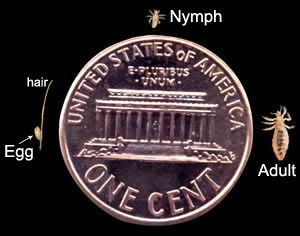- Head Lice
 As you can see from this picture, adult head lice are very small.
As you can see from this picture, adult head lice are very small.Treat the infested person(s): Requires using an Over-the-counter (OTC) or prescription medication. Follow these treatment steps:
- Before applying treatment, it may be helpful to remove clothing that can become wet or stained during treatment.
- Apply the lice medicine, also called pediculicide, according to the instructions contained in the box or printed on the label. If the infested person has very long hair (longer than shoulder length), it may be necessary to use a second bottle. Pay special attention to instructions on the label or in the box regarding how long the medication should be left on the hair and how it should be washed out.
Warning
Do not use a combination shampoo/conditioner, or conditioner before using lice medicine. Do not re–wash the hair for 1–2 days after the lice medicine is removed.
- Have the infested person put on clean clothing after treatment.
- If a few live lice are still found 8–12 hours after treatment but are moving more slowly than before, do not retreat. The medicine may take longer to kill all the lice. Comb dead and any remaining live lice out of the hair using a fine-toothed nit comb.
- If, after 8–12 hours of treatment, no dead lice are found and lice seem as active as before, the medicine may not be working. Do not retreat until speaking with your health care provider; a different pediculicide may be necessary. If your health care provider recommends a different pediculicide, carefully follow the treatment instructions contained in the box or printed on the label.
- Nit (head lice egg) combs, often found in lice medicine packages, should be used to comb nits and lice from the hair shaft. Many flea combs made for cats and dogs are also effective.
- After each treatment, checking the hair and combing with a nit comb to remove nits and lice every 2–3 days may decrease the chance of self–reinfestation. Continue to check for 2–3 weeks to be sure all lice and nits are gone. Nit removal is not needed when treating with spinosad topical suspension.
- Retreatment is meant to kill any surviving hatched lice before they produce new eggs. For some drugs, retreatment is recommended routinely about a week after the first treatment (7–9 days, depending on the drug), and for others only if crawling lice are seen during this period. Retreatment with lindane shampoo is not recommended.
Supplemental Measures: Head lice do not survive long if they fall off a person and cannot feed. You don’t need to spend a lot of time or money on housecleaning activities. Follow these steps to help avoid re-infestation by lice that have recently fallen off the hair or crawled onto clothing or furniture.
- Machine wash and dry clothing, bed linens, and other items that the infested person wore or used during the 2 days before treatment using the hot water (130°F) laundry cycle and the high heat drying cycle. Clothing and items that are not washable can be dry–cleaned OR sealed in a plastic bag and stored for 2 weeks.
- Soak combs and brushes in hot water (at least 130°F) for 5–10 minutes.
- Vacuum the floor and furniture, particularly where the infested person sat or lay. However, the risk of getting infested by a louse that has fallen onto a rug or carpet or furniture is very small. Head lice survive less than 1–2 days if they fall off a person and cannot feed; nits cannot hatch and usually die within a week if they are not kept at the same temperature as that found close to the human scalp. Spending much time and money on housecleaning activities is not necessary to avoid reinfestation by lice or nits that may have fallen off the head or crawled onto furniture or clothing.
- Do not use fumigant sprays; they can be toxic if inhaled or absorbed through the skin.
For further information: https://www.cdc.gov/parasites/lice/head/treatment.html
- Preventing Illnesses and Spread of Disease
Hand Washing – single most effective way to stop the spread of germs and virus’.
The following is courtesy of CDC – https://www.cdc.gov/handwashing.
When & How to Wash Your Hands
Keeping hands clean through improved hand hygiene is one of the most important steps we can take to avoid getting sick and spreading germs to others. Many diseases and conditions are spread by not washing hands with soap and clean, running water. If clean, running water is not accessible, as is common in many parts of the world, use soap and available water. If soap and water are unavailable, use an alcohol-based hand sanitizer that contains at least 60% alcohol to clean hands.
When should you wash your hands?
- Before, during, and after preparing food
- Before eating food
- Before and after caring for someone who is sick
- Before and after treating a cut or wound
- After using the toilet
- After changing diapers or cleaning up a child who has used the toilet
- After blowing your nose, coughing, or sneezing
- After touching an animal, animal feed, or animal waste
- After handling pet food or pet treats
- After touching garbage
How should you wash your hands?
- Wet your hands with clean, running water (warm or cold), turn off the tap, and apply soap.
- Lather your hands by rubbing them together with the soap. Be sure to lather the backs of your hands, between your fingers, and under your nails.
- Scrub your hands for at least 20 seconds. Need a timer? Hum the “Happy Birthday” song from beginning to end twice.
- Rinse your hands well under clean, running water.
- Dry your hands using a clean towel or air dry them.
Why? Read the science behind the recommendations.
Washing hands with soap and water is the best way to reduce the number of germs on them in most situations.
What should you do if you don’t have soap and clean, running water?
If soap and water are not available, use an alcohol-based hand sanitizer that contains at least 60% alcohol. Alcohol-based hand sanitizers can quickly reduce the number of germs on hands in some situations, but sanitizers do not eliminate all types of germs and might not remove harmful chemicals.
Hand sanitizers are not as effective when hands are visibly dirty or greasy.How do you use hand sanitizers?
- Apply the product to the palm of one hand (read the label to learn the correct amount).
- Rub your hands together.
- Rub the product over all surfaces of your hands and fingers until your hands are dry.
- Hepatitis A Update – Epidemic
The Indiana State Department of Health (ISDH) is urging Hoosiers to get vaccinated and take other steps to protect themselves from Hepatitis A if they plan to travel to states that are experiencing outbreaks of the disease: Indiana, Kentucky, Michigan, California, Arizona, and Utah.
The vaccine for Hepatitis A is a 2 shot series given 6 months apart. It is available for all ages. Most children born after 2010 have probably already gotten the series – first at or around 12 months old and the second 6 months later – if they are up-to-date with their vaccines. In Indiana, it is now required to be completed for all high school seniors, 6th graders and grades K through 4 – 2018/2019 school year. Clinton County Health Department has Hepatitis A available for Insured, Medicaid or Uninsured. Please contact us at (765) 659-6385 ext. 1309 to schedule an appointment.
The CDC states: Hepatitis A is a vaccine-preventable, communicable disease of the liver caused by the hepatitis A virus (HAV). It is usually transmitted person-to-person through the fecal-oral route or consumption of contaminated food or water. Most adults with hepatitis A have symptoms, including fatigue, low appetite, stomach pain, nausea and jaundice that usually resolve within 2 months of infection. Most children less than 6 years of age do not have symptoms or have an unrecognized infection. Antibodies produced in response to hepatitis A infection last for life and protects against reinfection. The best way to prevent hepatitis A infection is to get vaccinated.
Anyone who is exhibiting symptoms of hepatitis A should contact a healthcare provider immediately and refrain from preparing food for others. Hepatitis A virus is usually spread through feces (stool) of infected people but may also be spread through injection drug use.
Anyone who may be at risk, especially food handlers in schools, hospitals, restaurants, correctional institutions and other facilities that serve large numbers of people, is urged to get vaccinated. Always wash your hands with soap and warm water after going to the bathroom, after changing diapers and before preparing meal for yourself and others. Hepatitis A vaccine is available from health care providers, pharmacies and health departments.
Risk factors for Hepatitis A include:
- Travel to locations with high rates of hepatitis A
- Men who have sex with men
- Injection drug use
- A diagnosis of chronic liver disease
- Direct contact with individuals who have hepatitis A
For more information on hepatitis A, visit the ISDH website at https://www.in.gov/isdh/27791.htm.
- Shingles
Who Should Get Shingrix?
Healthy adults 50 years and older should get two doses of Shingrix, separated by 2 to 6 months. You should get Shingrix even if in the past you
- had shingles
- received Zostavax
- are not sure if you had chickenpox
There is no maximum age for getting Shingrix.
If you had shingles in the past, you can get Shingrix to help prevent future occurrences of the disease. There is no specific length of time that you need to wait after having shingles before you can receive Shingrix, but generally, you should make sure the shingles rash has gone away before getting vaccinated.
You can get Shingrix whether or not you remember having had chickenpox in the past. Studies show that more than 99% of Americans 40 years and older have had chickenpox, even if they don’t remember having the disease. Chickenpox and shingles are related because they are caused by the same virus (varicella-zoster virus). After a person recovers from chickenpox, the virus stays dormant (inactive) in the body. It can reactivate years later and cause shingles.
If you had Zostavax in the recent past, you should wait at least eight weeks before getting Shingrix. Talk to your healthcare provider to determine the best time to get Shingrix. If you have questions about Shingrix, talk with your healthcare provider. For more information from CDC: https://www.cdc.gov/vaccines/vpd/shingles/public/shingrix/index.html.
- Travel updates and warnings. Where to get vaccines. Typhoid available.
6 Tips for Healthy Holiday Travel Abroad
While you’re packing up presents and planning celebrations, prepare for healthy holiday travel:
- See a health care provider before you leave to get vaccines and medicines needed for your destination. Even if you are leaving soon, a doctor’s visit is still valuable. For example, it’s not too late to get a flu shot! CDC recommends getting a yearly flu shot before travel to protect you and your family/friends abroad that might be at a higher risk for flu complications.
- Pack a travel health kit. Include prescription and over-the-counter medicines, sunscreen, alcohol-based hand sanitizer, first aid supplies, health insurance cards, insect repellents, and condoms.
- Protect yourself in hot or cold climates and from sun exposure. Whether traveling to a tropical location or a snowy one, make sure you are prepared for the climate.
- Prevent insect bites. Using insect repellent can protect you from serious diseases spread by mosquitoes, such as Zika, dengue, and malaria.
- Wash your hands often. From cruise ships to cooking or eating with family/friends abroad outbreaks of vomiting and diarrhea, primarily caused by norovirus, are common. The best way to prevent illness is frequent handwashing with soap and water.
- Learn about health risks at your destination.
For more travel information from the CDC: https://www.cdc.gov/travel/notices
- Disposal of Sharps and Unwanted or Expired Medications
Sharps
Clinton County Health Department wants to help get needles, syringes, lancets, and other medical sharps out of the “regular” trash in our community. We offer FREE sharps containers exchange Monday thru Friday from 8 am to 3:45 pm. Bring in your current sharps container(s) and we will exchange for a new one.
Wondering about what to do with expired or unwanted medications?
You have two (2) options:
- Our local CVS store has a box back by the pharmacy, where you can bring your medications to place in the container – still in packaging, remove labels with personal information, please.
- Clinton County Sheriff’s Office. Please take pills in their original bottles to the east side of the Sheriff’s Office. Press the door buzzer to call for an attendant so you can dispose of medications in their container. They do NOT accept any needles, liquids, or hydrogen peroxide. They will not give any type of receipt upon disposal.
Do you have Hazardous Products that need disposal?
Wild Cat Solid Waste can help with that!
Located at the Frankfort Street Department
905 Burlington Ave. (across from the TPA Park).Put items in boxes.
Hours of operation
Monday, Tuesday, Thursday, Friday 9 am – 3 pm
First Saturday of the month from 9 am – 12N. Call (765) 659-4257 or toll-free 855-659-4257 for questions.Can handle acids, bases, batteries, bleach, chemistry sets, cleaners, fire extinguishers, pool/spa chemicals, adhesives, aerosol cans, ammunition, brake fluid, camping fuel, cooking oil, diesel fuel, fireworks, flares, gasoline, kerosene, mineral spirits, motor oil, oil filters, oil paint, oil stain, propane tanks, solvents, antifreeze, ballast, bug spray, fluorescent lamps, herbicides, some medications (call first), mercury, mole bait, smoke detectors, pesticides, poisons, weed killers and more.
- The Indiana State Department of Health’s Maternal and Child Health Division
Offers information and referral assistance with:
- Locating and connecting with a healthcare provider;
- Navigating health insurance enrollment;
- Baby programs;
- Immunizations;
- Baby items;
- Transportation providers;
- Free pregnancy, HIV and STI tests;
- Housing assistance;
- Nutrition;
- Education and
- Behavioral health providers
The mission of the Maternal and Child Health MOMS Helpline is to reduce the infant mortality rate in Indiana by connecting families with access to available resources focused on improving the health of mothers and their children.
For information on their full list of services, please visit http://www.MomsHelpLine.isdh.in.gov.
To connect with the MOMS Helpline call:
(844) MCH-MOMS
(844) 624-6667
Monday – Friday 7:30 am – 5:00 pm - Tobacco Cessation
The Indiana Tobacco Quitline is a free phone-based counseling service that helps Indiana smokers quit. Services include:
- One-on-one coaching for tobacco users who have decided to quit;
- Resources for healthcare providers who want to improve patient outcomes;
- Best practices for employers who want to implement smoke-free policies;
- Support for family and friends who want to help loved ones stop smoking and
- Tools for tobacco-control partners to complement their current programs.
Services are available 7 days a week in more than 170 languages. A trained quit coach will work with you and provide solutions tailored to your needs. For support information call 1-800-QUIT-NOW (800-784-8669) or visit: https://www.quitnow.net/indiana/
- Substance Use Disorder
People with substance use disorder have a disease and they cannot overcome it alone. Recovery involves support, respect, and growth in the community and in the individual. Definition of substance use disorder: Substance use disorders occur when the recurrent use of alcohol and/or drugs causes clinically and functionally significant impairment, such as health problems, disability, and failure to meet major responsibilities at work school, or home.
Commonly Used Addictive Drugs:
- Alcohol
- Amphetamines/Methamphetamine
- Benzodiazepines
- Cocaine
- Inhalants
- Nicotine
- Opioids
What is an opioid?
- Opioids are powerful painkillers that can be highly addictive and are dangerous. Opioids include illicit drugs such as heroin and carfentanil, as well as prescription medications used to treat pain such as Vicodin, morphine, codeine, oxycodone, hydrocodone, and fentanyl.
- Whether the opioid is prescribed by a doctor or acquired illegally, these drugs can cause serious changes to the brain and body.
- Continues use and misuse can lead to physical dependence and withdrawal symptoms. And after a while, people must take opioids just to avoid the physical withdrawal symptoms. Although some damage can occur with short-term drug use, the most extreme changes to the brain and body typically occur with long-term use and misuse of opioid painkillers.
- According to the data, Indiana is being affected by the opioid crisis. There are several stigmas that can prevent individuals with opioid dependence from seeking treatment. They do not have to become another overdose statistic.
- Let’s help reduce the stigma and help those being affected by knowing these basic facts:
- Opioid use disorder is a disease
- There is treatment
- Recovery is possible
- Know the facts. https://www.in.gov/recovery
-
Additional contact information:
- Get Help for substance abuse problems at 1-800-662-HELP (4357)
- Indiana Addiction Hotline: 1-800-662-4357
- Call Poison Help 1-800-222-1222
- Connect 2 Help @ 2-1-1 or http://www.connect2help211.org
- Aspire: 24-hour crisis services 1-800-560-4038 or aspireindiana.org
Language Translation


